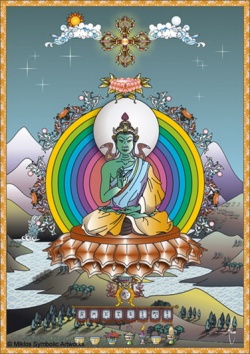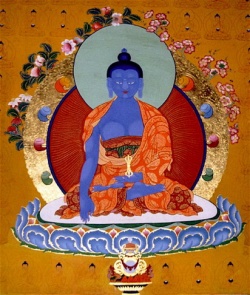Difference between revisions of "Five buddha families"
Jump to navigation
Jump to search
| Line 51: | Line 51: | ||
{{RigpaWiki}} | {{RigpaWiki}} | ||
| − | [[Category:Five Buddha Families]] | + | [[Category:Five Buddha Families]]{{BuddhismbyNumber}} |
Latest revision as of 10:26, 22 April 2014
Five buddha families (Skt. pañcakula; Wyl. rigs lnga, Tib. rik nga) — five buddha families (rig nga): The buddha, vajra, ratna, padma, and karma families.
- buddha family (Skt. tathāgatakula; Wyl. de bzhin gshegs pa'i rigs)
- vajra family (Skt. vajrakula; Wyl. rdo rje'i rigs)
- ratna family or jewel family (Skt. ratnakula)
- padma family or lotus family (Skt. padmakula; Wyl. pad ma'i rigs)
- karma family or action family (Skt. karmakula)
| Diagram of the Five Buddha Families[1] | |||||
| family | buddha | vajra | ratna | padma | karma |
| direction | centre | east | south | west | north |
| colour | blue | white | yellow | red | green |
| family symbol | eight-spoked wheel | vajra | jewel | lotus | double vajra or sword |
| masculine buddha[2] | Vairochana[3] | Vajrasattva-Akshobhya[4] | Ratnasambhava | Amitabha | Amoghasiddhi |
| wisdom[5] | wisdom of dharmadhatu | mirror-like wisdom | wisdom of equality | wisdom of discernment | all-accomplishing wisdom |
| poison[6] | delusion or ignorance | anger | pride | desire | jealousy |
| skhanda[7] | form | consciousness | feeling | perception | formations |
| feminine buddha[8] | Dhatvishvari | Buddhalochana or Mamaki | Mamaki or Lochana | Pandaravasini | Samayatara |
| element[9] | space | water | earth | fire | air |
Footnotes
- ↑ Version based on the Nyingma, inner tantras
- ↑ each family is associated with one of the buddhas of the five families
- ↑ in the Sarma tantras, Akshobhya is often at the centre of the mandala, instead of Vairochana
- ↑ in the Sarma tantras, Vairochana is often in the eastern direction, instead of Akshobhya
- ↑ each buddha is associated to one of the five wisdoms
- ↑ each wisdom is a transmutation of one of the five poisons
- ↑ each buddha is associated to one of the five skandhas
- ↑ in union with each of the five buddhas
- ↑ each female buddha represents the purity of one of the five elements
Further Reading
- Chögyam Trungpa,
- Journey Without Goal: The Tantric Wisdom of the Buddha, The Collected Works of Chögyam Trungpa, Volume Four (Boston & London: Shambhala, 2003), Ch. 9 'The Five Buddha Families'.
- The Lion’s Roar: An Introduction to Tantra, The Collected Works of Chögyam Trungpa, Volume Four (Boston & London: Shambhala, 2003), Part Two, Ch. 7 'The Five Buddha Families and Mahamudra'.

